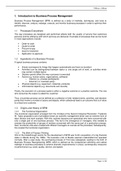TBKLeo X OMLeo
1. Introduction to Business Process Management
Business Process Management (BPM) is defined as a body of methods, techniques, and tools to
identify, discover, analyze, redesign, execute, and monitor business processes in order to optimize their
performance.
1.1 Processes Everywhere
The way processes are designed and performed affects both the quality of service that customers
perceive and the efficiency with which services are delivered. Examples of processes that can be found
in most organizations include:
• Order-to-cash
• Quote-to-order
• Procure-to-pay
• Issue-to-resolution
• Application-to-approval
1.2 Ingredients of a Business Process
A typical business process contains:
• Events (correspond to things that happen automatically and have no duration)
• Activities (can be distinguished between tasks i.e. one single unit of work, or activities which
may contain multiple tasks)
• Decision points (affect the way a process is executed)
• Actors (e.g. human actors, organizations, software)
o Internal (i.e. process participants)
o External (i.e. business party)
• Physical objects (e.g. equipment, materials, products)
• Informational objects (e.g. documents and records)
Finally, the execution of a process leads to either a negative outcome or a positive outcome. The one
who consumes the output is called the customer.
Thus, a business process can be defined as a collection of inter-related events, activities, and decision
points that involve a number of actors and objects, which collectively lead to an outcome that is of value
to at least one customer.
1.3 Origins and History of BPM
1.3.1 The Functional Organization
The functional organization emerged from the mindset of the Second Industrial Revolution. Frederick
W. Taylor proposed a set of principles known as scientific management which was an extreme form of
labor division and work analysis. With this, workers became pure specialists who were concerned with
only a single part of one business process. This led to the emergence of managers, who needed to
oversee the productivity of groups of workers concerned with the same part of a production process.
Next, functional units were created with different managers to oversee all the processes. Subsequently,
this created the functional organization.
1.3.2 The Birth of Process Thinking
One of the breakthrough events for the development of BPM was Ford’s acquisition of a big financial
stake in Mazda during the 1980s. The business units of Mazda seemed understaffed but operated
normally. After a case study, the purchasing process of Ford was redesigned, leading to the birth of
Business Process Reengineering (BPR) which is defined as the fundamental rethinking and radical
redesign of business processes to achieve dramatic improvements in critical, contemporary measures
of performance e.g. costs, quality, service, and speed.
Page 1 of 40
, TBKLeo X OMLeo
1.3.3 The Rise and Fall of BPR
The enthusiasm for BPR faded away by the late 1990s, this can be explained by three factors:
1. Concept misuse (improvement projects were inappropriately labeled as BPR)
2. Over-radicalism (sometimes, a more gradual approach was better suited)
3. Support immaturity (no rigid infrastructure available in that time)
However, empirical studies appeared with showed the benefits of BPR. For process-oriented
organizations that used BPR, they:
• Showed better overall performance
• Tend to have a better esprit de corps
• Suffered less from inter-functional conflicts
Now, BPR should be seen as a subset of techniques that can be used in the context of BPM.
1.4 The BPM Lifecycle
The BPM lifecycle (figure 1.1) is continuous and consists of:
• Process identification
• Process discovery
• Process analysis
• Process redesign
• Process implementation
• Process monitoring
Many stakeholders are involved in a
business process throughout its
lifecycle. Among them we distinguish
the following individuals and groups:
• Management team
• Process owners
• Process participants
• Process analysts
• Process methodologist
• System engineers
• BPM group
Figure 1.1: the BPM lifecycle
Page 2 of 40





